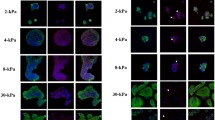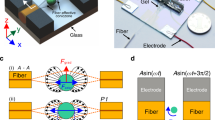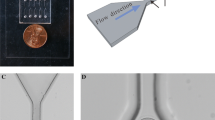Abstract
Endometriosis affects 5–10% of women in reproductive age and causes pelvic pain and subfertility. Exact etiology of the disease is unknown. Here, we present a microfluidic platform for characterizing mechanical properties of eutopic endometrial stromal cells of endometriosis patients based on cellular deformability inside narrow microchannels. Primary human endometrial stromal cells were isolated from eutopic endometrium of endometriosis patients (4407 cells, from 7 endometriosis patients) and from disease-free women (4541 cells, from 6 control women) and were pumped through microchannels (formed of polydimethylsiloxane (PDMS) by standard soft lithography, with dimensions of 8 × 20 × 150 μm, as width × height × length) at a constant flow rate of 2 μL/min. High-speed imaging was used to capture videos of cells as they flow inside microchannels, and a computer vision code was used to track cells, measure their area, and calculate the time each cell takes to pass through the microchannel. Compared with their counterparts from control women, eutopic endometrial stromal cells from endometriosis patients showed significantly increased deformation index (1.65 ± 0.2 versus 1.43 ± 0.19, respectively, P value < 0.001), and higher velocity in travelling through narrow microchannels (96.530 ± 0.710 mm/s versus 57.518 ± 0.585 mm/s, respectively, P value < 0.001). The same difference in velocities between the two cell types was maintained after controlling for cell area. Eutopic endometrial stromal cells of endometriosis patients showed a mechanical phenotype characterized by high deformability and reduced stiffness. This mechanical signature can represent basis of a mechanical biomarker of endometriosis.







Similar content being viewed by others
References
Fassbender A, Vodolazkaia A, Saunders P, Lebovic D, Waelkens E, De Moor B, et al. Biomarkers of endometriosis. Fertil Steril. 2013;99(4):1135–45.
Eskenazi B, Warner ML. Epidemiology of endometriosis. Obstet Gynecol Clin N Am. 1997;24(2):235–58.
Falcone T, Flyckt R. Clinical management of endometriosis. Obstet Gynecol. 2018;131(3):557–71.
Nnoaham KE, Hummelshoj L, Webster P, d’Hooghe T, de Cicco NF, de Cicco NC, et al. Impact of endometriosis on quality of life and work productivity: a multicenter study across ten countries. Fertil Steril. 2011;96(2):366–373.e8.
Pearce CL, Templeman C, Rossing MA, Lee A, Near AM, Webb PM, et al. Association between endometriosis and risk of histological subtypes of ovarian cancer: a pooled analysis of case-control studies. Lancet Oncol. 2012;13(4):385–94.
Dunselman GA, Vermeulen N, Becker C, Calhaz-Jorge C, D’Hooghe T, De Bie B, et al. ESHRE guideline: management of women with endometriosis. Hum Reprod. 2014;29(3):400–12.
HarkkiSiren P, Kurki T. A nationwide analysis of laparoscopic complications. Obstet Gynecol. 1997;89(1):108–12.
Ballard K, Lowton K, Wright J. What’s the delay? A qualitative study of women’s experiences of reaching a diagnosis of endometriosis. Fertil Steril. 2006;86(5):1296–301.
Patel BG, Lenk EE, Lebovic DI, Shu Y, Yu J, Taylor RN. Pathogenesis of endometriosis: interaction between endocrine and inflammatory pathways. Best Pract Res Clin Obstet Gynaecol. 2018;50:50–60.
Sampson JA. Peritoneal endometriosis due to the menstrual dissemination of endometrial tissue into the peritoneal cavity. Am J Obstet Gynecol. 1927;14:422–69.
Giudice LC. Endometriosis. N Engl J Med. 2010;362(25):2389–98.
Giudice LC, Kao LC. Enometriosis. Lancet. 2004;364(9447):1789–99.
Matsuzaki S, Canis M, Pouly JL, Darcha C. Soft matrices inhibit cell proliferation and inactivate the fibrotic phenotype of deep endometriosis stromal cells in vitro. Hum Reprod. 2016;31(3):541–53.
Burney RO, Giudice LC. Pathogenesis and pathophysiology of endometriosis. Fertil Steril. 2012;98(3):511–9.
Guo SW. Recurrence of endometriosis and its control. Hum Reprod Update. 2009;15(4):441–61.
Davis AC, Goldberg JM. Extrapelvic endometriosis. Semin Reprod Med. 2017;35(1):98–101.
Anglesio MS, Papadopoulos N, Ayhan A, Nazeran TM, Noë M, Horlings HM, et al. Caner- associated mutations in endometriosis without cancer. N Engl J Med. 2017;376(19):1835–48.
Lekka M, Gil D, Pogoda K, Dulińska-Litewka J, Jach R, Gostek J, et al. Cancer cell detection in cancer tissue sections using AFM. Arch Biochem Biophys. 2012;518(2):151–619.
Suresh S. Nanomedicine: elastic clues in cancer detection. Nat Nanotechnol. 2007;2(12):748–9.
Ciasca G, Papi M, Minelli E, Palmieri V, De Spirito M. Changes in cellular mechanical properties during onset or progression of colorectal cancer. World J Gastroenterol. 2016;22(32):7203–14.
Hou HW, Li QS, Lee GYH, Kumar AP, Ong CN, Lim CT. Deformability study of breast cancer cells using microfluidics. Biomed Microdevices. 2009;11(3):557–64.
Herbig M, Krater M, Plak K, Muller P, Guck J, Otto O. Real-time deformability cytometry: label-free functional characterization of cells. In: Hawley TS, Hawley RG, editors. Flow cytometry protocols, vol. 2018. 4th ed; 1678. p. 347–69.
Gossett DR, Tse HT, Lee SA, Ying Y, Lindgren AG, Yang OO, et al. Hydrodynamic stretching of single cells for large population mechanical phenotyping. Proc Natl Acad Sci U S A. 2012;109(20):7630–5.
Guck J, Ananthakrishnan R, Mahmood H, Moon TJ, Cunningham CC, Käs J. The optical stretcher: a novel laser tool to micromanipulate cells. Biophys J. 2001;81(2):767–84.
Carrarelli P, Funghi L, Bruni S, Luisi S, Arcuri F, Petraglia F. Naproxen sodium decreases prostaglandins secretion from cultured human endometrial stromal cells modulating metabolizing enzymes mRNA expression. Gynecol Endocrinol. 2016;32(4):319–22.
Duffy DC, McDonald JC, Schueller OJA, Whitesides GM. Rapid prototyping of microfluidic systems in poly(dimethylsiloxane). Anal Chem. 1998;70(23):4974–84.
Haubert K, Drier T, Beebe D. PDMS bonding by means of a portable, low-cost corona system. Lab Chip. 2006;6(12):1548–9.
Esmaeel AM, ElMelegy T, Abdelgawad M. Multi-purpose machine vision platform for different microfluidics applications. Biomed Microdevices. 2019;21:1–13. https://doi.org/10.1007/s10544-019-0401-1.
Weimar CHE, Macklon NS, Uiterweer EDP, Brosens JJ, Gellersen B. The motile and invasive capacity of human endometrial stromal cells: implications for normal and impaired reproductive function. Hum Reprod Update. 2013;19(5):542–57.
Witz CA, Dechaud H, Montoya-Rodriguez IA, Thomas MR, Nair AS, Centonze VE, et al. An in vitro model to study the pathogenesis of the early endometriosis lesion. Ann N Y Acad Sci. 2002;955:296–307 Discussion 340–292, 396–406.
Witz CA, Cho S, Centonze VE, Montoya-Rodriguez IA, Schenken RS. Time series analysis of transmesothelial invasion by endometrial stromal and epithelial cells using three-dimensional confocal microscopy. Fertil Steril. 2003;79(Suppl. 1):770–8.
Ferreira MC, Witz CA, Hammes LS, Kirma N, Petraglia F, Schenken RS, et al. Activin A increases invasiveness of endometrial cells in an in vitro model of human peritoneum. Mol Hum Reprod. 2008;14:301–7.
Ornek T, Fadiel A, Tan O, Naftolin F, Arici A. Regulation and activation of ezrin protein in endometriosis. Hum Reprod. 2008;23(9):2104–12.
Wenwei X, Roman M, Byungkyu K, Lijuan W, John M, Todd S. Cell stiffness is a biomarker of the metastatic potential of ovarian cancer cells. PLoS One. 2012;7:e46609.
Quan FS, Kim KS. Medical applications of the intrinsic mechanical properties of single cells. Acta Biochim Biophys Sin (Shanghai). 2016;48(10):865.
Suresh S. Biomechanics, and biophysics of cancer cells. Acta Biomater. 2007;3(4):413–38.
Lawson CD, Ridley AJ. Rho GTPase signaling complexes in cell migration and invasion. J Cell Biol. 2018;217(2):447–57.
Matsui T, Maeda M, Doi Y, et al. Rho-kinase phosphorylates COOH-terminal threonines of ezrin/radixin/moesin (ERM) proteins and regulates their head-to-tail association. JCell Biol. 1998;140(3):647–57.
Yotova IY, Quan P, Leditznig N, Beer U, Wenzl R, Tschugguel W. Abnormal activation of Ras/Raf/MAPK and RhoA/ROCKII signalling pathways in eutopic endometrial stromal cells of patients with endometriosis. Hum Reprod. 2011;26(4):885–97.
Yotova I, Quan P, Gaba A, Leditznig N, Pateisky P, Kurz C, et al. Raf-1 levels determine the migration rate of primary endometrial stromal cells of patients with endometriosis. J Cell Mol Med. 2012;16(9):2127–39.
Wu ZY, Yang XM, Cheng MJ, Zhang R, Ye J, Yi H, et al. Dysregulated cell mechanical properties of endometrial stromal cells from endometriosis patients. Int J Clin Exp Pathol. 2014;7(2):648–55.
Gentilini D, Vigano P, Somigliana E, Vicentini LM, Vignali M, Busacca M, et al. Endometrial stromal cells from women with endometriosis reveal peculiar migratory behavior in response to ovarian steroids. Fertil Steril. 2010;93(3):706–15.
Mu L, Zheng W, Wang L, Chen X-J, Zhang X, Yang JH. Alteration of focal adhesion kinase expression in eutopic endometrium of women with endometriosis. Fertil Steril. 2008;89(3):529–37.
Cross SE, Jin YS, Rao J, Gimzewski JK. Nanomechanical analysis of cells from cancer patients. Nat Nanotechnol. 2007;2(12):780–3.
Li QS, Lee GY, Ong CN, Lim CT. AFM indentation study of breast cancer cells. Biochem Biophys Res Commun. 2008;374:609–13.
Panzetta V, Musella I, Rapa I, Volante M, Netti PA, Fusco S. Mechanical phenotyping of cells and extracellular matrix as grade and stage markers of lung tumor tissues. Acta Biomater. 2017;57:334.
Nguyen AV, Nyberg KD, Scott MB, Welsh AM, Nguyen AH, Wu N, et al. Stiffness of pancreatic cancer cells is associated with increased invasive potential. Integr Biol (Camb). 2016;8(12):1232–45.
Xu W, Mezencev R, Kim B, Wang L, McDonald J, Sulchek T. Cell stiffness is a biomarker of the metastatic potential of ovarian cancer cells. PLoS One. 2012;7:e46609.
Lekka M, Laidler P, Gil D, Lekki J, Stachura Z, Hrynkiewicz AZ. Elasticity of normal and cancerous human bladder cells studied by scanning force microscopy. Eur Biophys J. 1999;28(4):312–6.
Fuldeore M, Chwalisz K, Marx S, Wu N, Boulanger L, Ma L, et al. Surgical procedures and their cost estimates among women with newly diagnosedendometriosis: a US database study. J Med Econ. 2011;14(1):115–23.
Yokokawa R, Saika T, Nakayama T, Fujita H, Konishi S. On-chip syringe pumps for picoliter-scale liquid manipulation. Lab Chip. 2006;6(8):1062–6.
Wang KI, Salcic Z, Yeh J, Akagi J, Zhu F, Hall CJ, et al. Biosensors and bioelectronics toward embedded laboratory automation for smart lab-on-a-chip embryo arrays. Biosens Bioelectron. 2013;48:188–96.
Al-Mofty S, Elbadri N, Altayyeb A, Omar O, Elsayed M, Shamseldine A, et al. One stop lab-on-chip platform for tissue processing and cell sample preparation. 20th International Conference on Miniaturized Systems for Chemistry and Life Sciences, MicroTAS 2016, Dublin, Ireland.
Ji HM, Samper V, Chen Y, Heng CK, Lim TM, Yobas L. Silicon-based microfilters for whole blood cell separation. Biomed Microdevices. 2008;10(2):251–7.
Acknowledgments
The authors would like to acknowledge Professor Felice Petraglia, University of Florence, Italy, and Dr. Felice Arcuri, Siena University, Italy, for providing the protocol for endometrial stromal cell isolation and culture.
Funding
The study was funded by a grant from Science and Technology Development Fund of Egypt (STDF) to E.O. (grant ID # 5525). Microchannels used in this study were fabricated at the clean room of the Faculty of Engineering which was established through a grant from the Science and Technology Development Fund of Egypt (STDF) to M.A. (grant ID # 4918).
Author information
Authors and Affiliations
Corresponding authors
Ethics declarations
All participating women provided written informed consent. Institutional Review Board at Faculty of Medicine, Assiut University, approved the use of human endometrial tissue samples for this study.
Conflict of Interest
The authors declare that they have no conflict of interest.
Additional information
Publisher’s Note
Springer Nature remains neutral with regard to jurisdictional claims in published maps and institutional affiliations.
Rights and permissions
About this article
Cite this article
Altayyeb, A., Othman, E., Khashbah, M. et al. Characterization of Mechanical Signature of Eutopic Endometrial Stromal Cells of Endometriosis Patients. Reprod. Sci. 27, 364–374 (2020). https://doi.org/10.1007/s43032-019-00042-3
Received:
Accepted:
Published:
Issue Date:
DOI: https://doi.org/10.1007/s43032-019-00042-3




